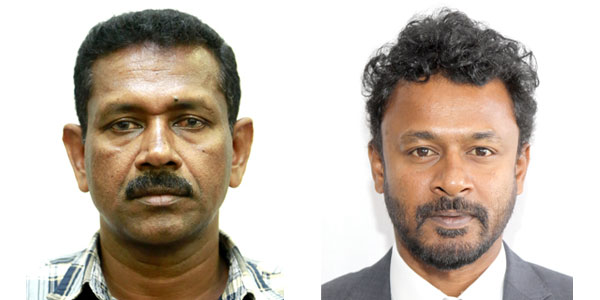In what appears to be a brazen assault on one of Sri Lanka’s most precious ecosystems, government-linked politicians and business interests are advancing illegal access through the Knuckles Conservation Forest a UNESCO-listed component of the Central Highlands of Sri Lanka. Once protected as a biodiversity haven, this range now stands threatened by attempts to carpet and open an 8-kilometre jeep safari route deep within its heart.
Environmentalist Sajiva Chamikara alleges that MPs E.M. Basnayake and Jagath Manuwarna, in collaboration with the Medadumbara Divisional Secretary and local tourism entrepreneurs, have secretly secured approvals to construct and pave a road cutting from Tangappuwa through into the core of the Knuckles range. According to Chamikara, the initiative is being driven not for conservation or community benefit but for commercial safari operations and hotel expansions.
 E.M. Basnayake and Jagath Manuwarna
E.M. Basnayake and Jagath Manuwarna
The Knuckles range, declared a World Heritage site for its globally significant biodiversity and status as one of Sri Lanka’s most intact montane ecosystems, is home to unique plant and animal life found nowhere else.
Developers are reportedly targeting the forest trail from Tangappuwa to Corbett’s Gap – slicing through the protected zone – under cover of “tourism development”. A meeting held on 22 August 2025, organised by the Land Use Planning Department at the International Buddhist Centre in Rangala, reportedly approved the plan, with participation by Manuwarna, the Tourism Minister’s private secretary, the Divisional Secretary and the Forest Conservation Department.
Chamikara says that subsequent meetings on 30 September and 30 October 2025, convened by the Divisional Development Committee, further progressed the agenda: hotel owners and safari jeep operators, some implicated in illegal land dealings inside the forest, pitched for vehicle access and road infrastructure. Eventually, it is alleged, Basnayake and the Divisional Secretary granted unauthorised permission to open the forest trail for safari jeeps.
If realised, the impact will be catastrophic. The Knuckles region accounts for more than one-third of Sri Lanka’s endemic flora, and half of its endemic vertebrates.
Ecosystem fragmentation, canopy removal, road construction and carpet surfacing in such a sensitive area especially one bridging wet and dry climatic zones threaten to raise local temperatures, disturb micro-habitats and invite invasive species such as Bovitiya to proliferate. Witnesses warn that the chain-reaction will include wildlife mortality from increased vehicle traffic, habitat loss and ecosystem collapse.
Chamikara charges that the scheme is being orchestrated by local power brokers: led by Ven. Dr. Kendagolle Sumanaransi Thera of the Tangappuwa-Rangala Buddhist Centre, the alliance reportedly includes hotel owner Dixon Tennakoon (Knuckles Base Camp), G.K.G. Gunathilaka (Knuckles Ceylon Bungalow) and several other businessmen, all working in league with political hand-tails and officials. The collusion of money, politics and conservation in this case paints a stark picture of governance failure.
The timing is telling. Under the banner of the government’s “Prosperous Country, Beautiful Life” slogan, the Central Provincial Road Development Authority is already advancing the Theldeniya-Corbett’s Gap road, with the section outside the forest already under development. The eight-kilometre segment inside the reserve, however, remains off official maps—until now.
As Sri Lanka balances tourism ambitions with conservation responsibilities, this story raises fundamental questions: Who protects the protected places? And how will the state account for the wholesale dismantling of a UNESCO-designated treasure? With the Knuckles at stake, the time for scrutiny, transparency and accountability has arrived.

Leave your comments
Login to post a comment
Post comment as a guest